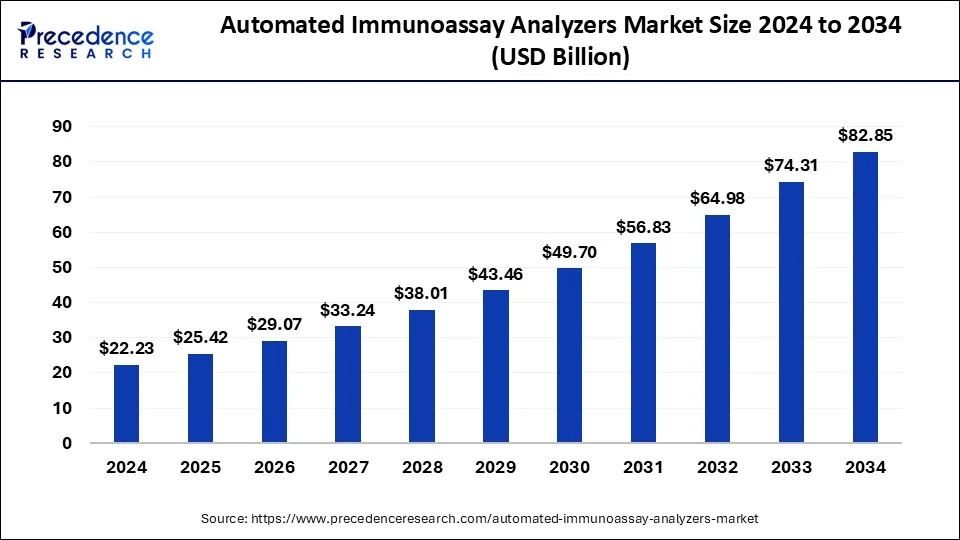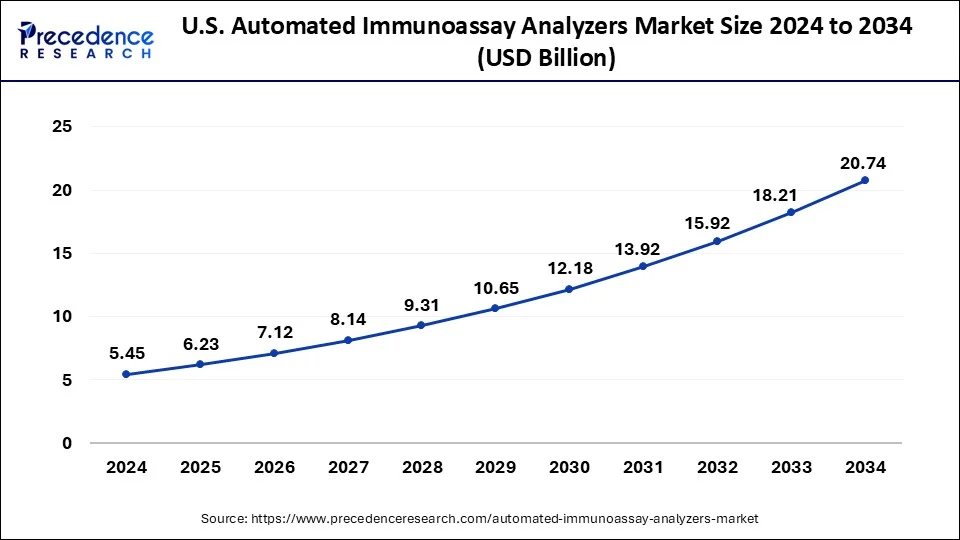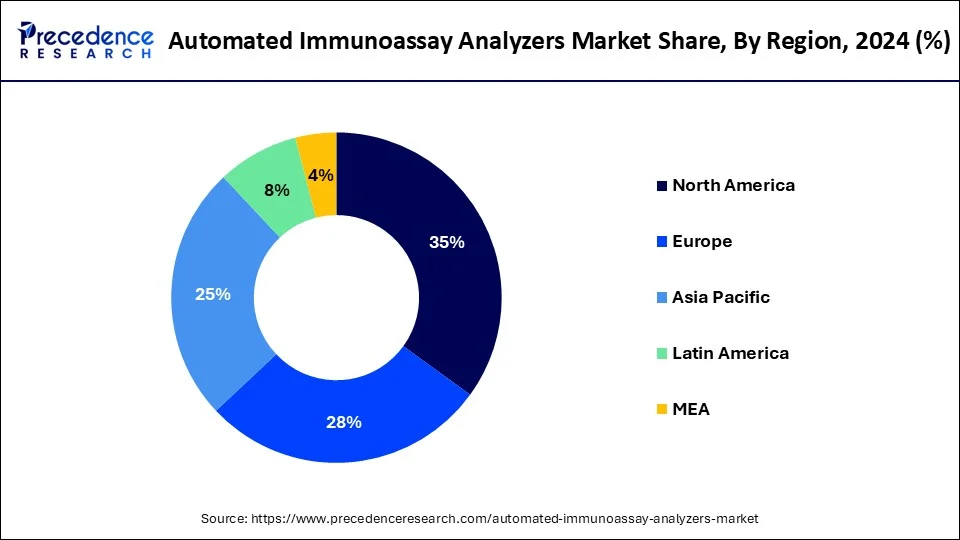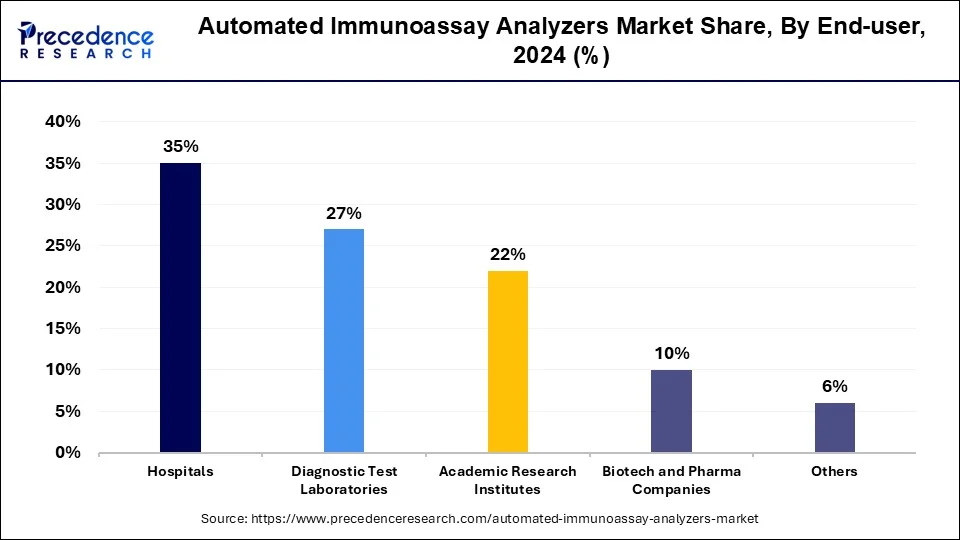December 2024
The global automated immunoassay analyzers market size is calculated at USD 25.42 billion in 2025 and is forecasted to reach around USD 82.85 billion by 2034, accelerating at a CAGR of 14.06% from 2025 to 2034. The North America automated immunoassay analyzers market size surpassed USD 7.78 billion in 2024 and is expanding at a CAGR of 14.22% during the forecast period. The market sizing and forecasts are revenue-based (USD Million/Billion), with 2024 as the base year.
The global automated immunoassay analyzers market size was estimated at USD 22.23 billion in 2024 and is predicted to increase from USD 25.42 billion in 2025 to approximately USD 82.85 billion by 2034, expanding at a CAGR of 14.06% from 2025 to 2034.

The U.S. automated immunoassay analyzers market size reached USD 5.45 billion in 2024 and is expected to be worth around USD 20.74 billion by 2034 at a CAGR of 14.30% from 2025 to 2034.

North America held the dominant share of the automated immunoassay analyzers market in 2024. The region is observed to witness prolific growth during the forecast period. The growth of the region is driven by the presence of prominent market players, a well-established healthcare infrastructure, a rising genetic population, and an increasing number of hospitals and diagnostic centers. Moreover, the increasing deployment of innovative technologies and the increasing prevalence of chronic diseases are likely to contribute to the growth of the region’s growth.
Among all countries, the United States is the major contributor to the automated immunoassay analyzers market. Factors such as a rise in healthcare expenditure, rising incidence of infectious diseases, increasing research and development expenditures, rapid advancement in technology, increasing demand for clinical diagnostic of immunoassay analyzers for various applications, and an increasing trend towards lab automation. Automation reduces the time needed for sample processing and enables faster turnaround times and accurate diagnoses of patients. Automated immunoassay analyzers reduce human error and enhance accuracy in managing the incubation periods, volumes, and other variables. It can also perform numerous tests simultaneously on a single sample.

Asia Pacific is observed to expand at a rapid pace during the forecast period owing to the increasing investment in the healthcare infrastructure, rise in government initiatives for providing better healthcare facilities, technology improvement in the field of lab equipment, increasing prevalence of chronic, rising demand for diagnostic solutions, increase in R&D activities, and increasing aging population. In addition, prominent market players are engaged in strategic approaches such as new product launches, partnerships or collaborations, acquisitions, and mergers.
Immunoassay is a method that is used to accurately identify the presence of a substance in the human body such as antibody, antigen, pathogen, hormone, enzyme, and others. An automated Immunoassay analyzer is an analytical instrument used in the field of healthcare. Automated immunoassay analyzers provide quantitative measurements of analytes, offering healthcare professionals a clear understanding of the concentration of specific substances in the sample. This information is vital for disease diagnosis and monitoring. An immunoassay assists in detecting the presence or absence of a specific substance within the body. In recent years, the automated immunoassay analyzers market has observed the application of immunoassays has evolved tremendously. It is a cutting-edge technology and a type of point-of-care testing.
The instrument uses antigens to detect the existence of target biological substances in the blood and other bodily fluids. Clinical laboratories and hospitals run automated biochemical tests by using automatic immunoassay analyzers. Many types of tests are performed by automatic immunoassay analyzers such as therapeutic drug monitoring, testing for cancer markers, cardiac analysis, diagnosing infectious diseases, allergy testing, and others.
| Report Coverage | Details |
| Global Market Size in 2024 | USD 22.23 Billion |
| Global Market Size in 2025 | USD 25.42 Billion |
| Global Market Size by 2034 | USD 82.85 Billion |
| Market Growth Rate from 2025 to 2034 | CAGR of 14.06% |
| Largest Market | North America |
| Base Year | 2024 |
| Forecast Period | 2025 to 2034 |
| Segments Covered | Product, Application, End User, and Region |
| Regions Covered | North America, Europe, Asia-Pacific, Latin America, and Middle East & Africa |
Increasing prevalence of chronic diseases
The rising prevalence of infectious and chronic diseases such as HIV, cardiovascular disease, cancer, diabetes, autoimmune disorders, and others is one of the major driving factors contributing to the growth of the automated immunoassay analyzers market. Immunoassays play a vital role in disease diagnosis and assist in early treatment to avoid complications. The automated immunoassay analyzer is used for the detection and quantification of various analytes in biological samples, such as urine and blood, through immunoassay techniques.
The increasing use of technologically advanced immunoassay analyzers helps to determine infectious diseases. The accurate diagnosis of microorganism-based illnesses will aid in treatment planning effectively. Therefore, the increasing incidence of chronic diseases around the globe has resulted in a rise in diagnostic tests propelling the growth of the market.
Lack of skilled professional
The lack of skilled professionals in the healthcare sector is anticipated to hamper the automated immunoassay analyzers market's expansion. The operation of automated immunoassay analyzers requires a set of skills. In addition, the lack of sophisticated healthcare infrastructure and less awareness regarding advanced diagnostic equipment in underdeveloped countries or economically backward regions restricts the expansion of the market.
Opportunity
Technological advancements
Multiple technological advancements in the automated immunoassay analyzers market have led to efficient and easy application, this factor is observed to create a set of lucrative opportunities in the industry. Simultaneous detection of immunoassays with advanced solutions and integration of AI into the systems are observed to be the most promising advancements in the field. Laser-based detection systems offer improved sensitivity, specificity, and dynamic range compared to traditional detection methods. By employing lasers to excite fluorescent labels or chemiluminescent substrates, these analyzers achieve enhanced signal detection and quantification of biomolecules, enabling accurate measurement of low-abundance analytes in complex biological samples.
The chemiluminescence segment accounted for the dominating share of the automated immunoassay analyzers market in 2024 owing to its high accuracy and high sensitivity of the diagnosis using low analytes concentration. Chemiluminescence immunoassay is a widely used laboratory technique for detecting specific analytes. It assists in the detection and analysis of various antibodies, antigens, enzymes, fatty acids, hormones, proteins, and others. It is also used in the fields of clinical diagnosis, life science, environmental monitoring, drug analysis, and others.
The Immunofluorescence segment is expected to witness a significant share during the forecast period. This automated immunofluorescence analyzer is widely used by healthcare professionals in the diagnosis of health conditions such as pregnancy, infection, diabetes, cardiovascular disease, renal injury, and cancer. This instrument provides reliable and quantitative results for a variety of analytes in human urine and blood.
The infectious diseases segment held the largest share of the automated immunoassay analyzers market in 2024, the segment is expected to sustain the position throughout the forecast period. The increasing number of infectious diseases around the world such as coronavirus (COVID-19), hepatitis, influenza, HIV, measles, and others increases the adoption of automated immunoassay analyzers in the healthcare sector.
The chronic diseases segment is expected to grow significantly during the forecast period. The growth of the segment is driven by the rising cases of chronic diseases globally including heart disease, stroke, cancer, type 2 diabetes, arthritis, and others. The increasing prevalence of chronic diseases leads to a surge in demand for advanced diagnostic solutions for accurate disease diagnosis and monitoring. These automated immunoassay analyzers offer high throughput, accuracy, and efficiency, making them vital tools in clinical diagnostics. Thereby fueling the segment’s growth.
The hospitals segment held the largest share of the automated immunoassay analyzers market in 2024. The growth of the segment is driven by the rising use of automated immunoassay analyzers by doctors and healthcare professionals in hospitals for detecting and monitoring diseases in patients. In addition, the presence of well-established healthcare infrastructure, availability of skilled professionals, and access to advanced equipment for rapid and accurate diagnostic testing.

The diagnostic test laboratories segment is expected to grow fastest during the forecast period owing to the increasing deployment of automated immunoassay analyzers for in vitro detection of human serum, plasma, whole blood, and urine samples.
By Product
By Application
By End User
By Geography
For inquiries regarding discounts, bulk purchases, or customization requests, please contact us at sales@precedenceresearch.com
No cookie-cutter, only authentic analysis – take the 1st step to become a Precedence Research client
December 2024
November 2024
November 2024
November 2024